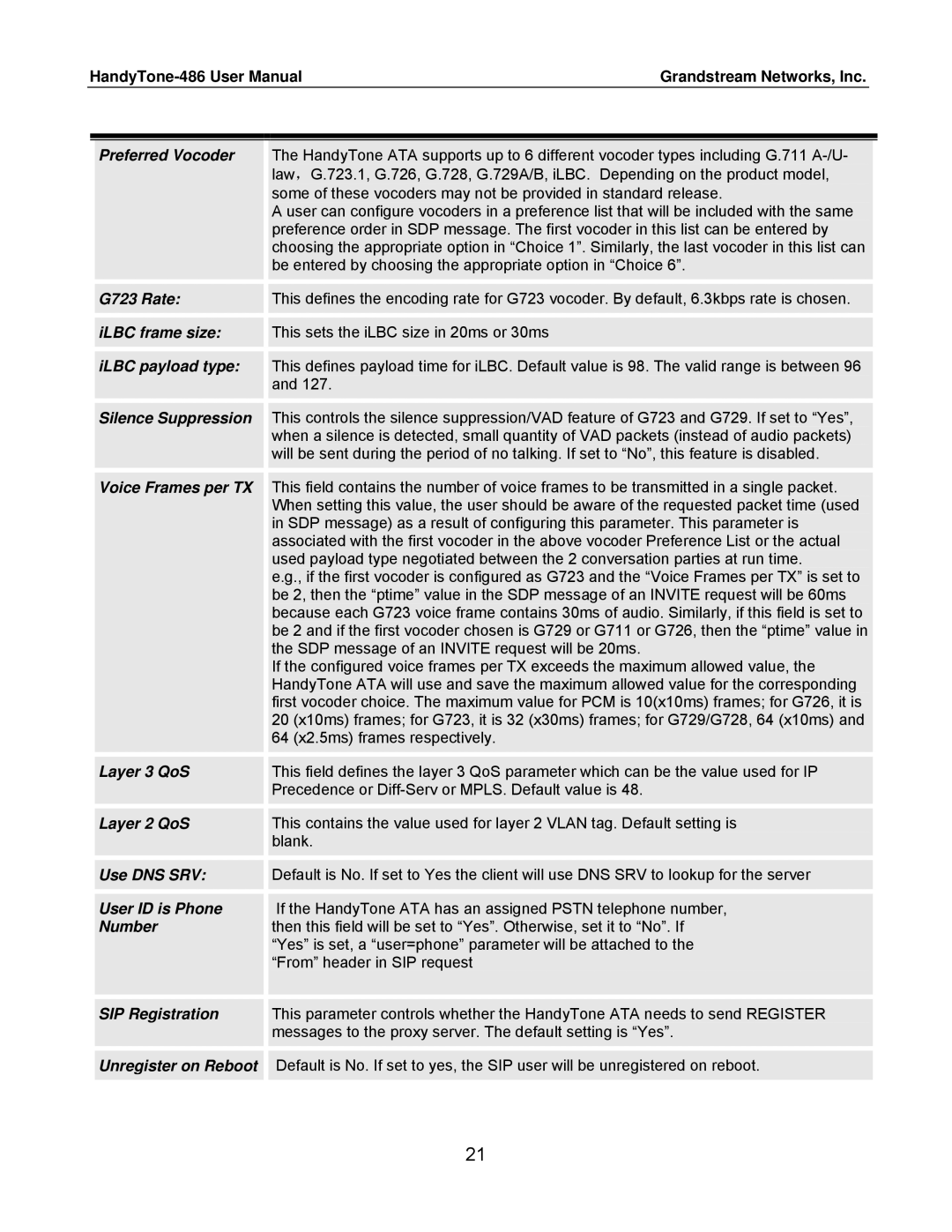
Grandstream Networks, Inc. |
Preferred Vocoder | The HandyTone ATA supports up to 6 different vocoder types including G.711 |
| law,G.723.1, G.726, G.728, G.729A/B, iLBC. Depending on the product model, |
| some of these vocoders may not be provided in standard release. |
| A user can configure vocoders in a preference list that will be included with the same |
| preference order in SDP message. The first vocoder in this list can be entered by |
| choosing the appropriate option in “Choice 1”. Similarly, the last vocoder in this list can |
| be entered by choosing the appropriate option in “Choice 6”. |
G723 Rate: | This defines the encoding rate for G723 vocoder. By default, 6.3kbps rate is chosen. |
iLBC frame size: | This sets the iLBC size in 20ms or 30ms |
iLBC payload type: | This defines payload time for iLBC. Default value is 98. The valid range is between 96 |
| and 127. |
Silence Suppression | This controls the silence suppression/VAD feature of G723 and G729. If set to “Yes”, |
| when a silence is detected, small quantity of VAD packets (instead of audio packets) |
| will be sent during the period of no talking. If set to “No”, this feature is disabled. |
Voice Frames per TX | This field contains the number of voice frames to be transmitted in a single packet. |
| When setting this value, the user should be aware of the requested packet time (used |
| in SDP message) as a result of configuring this parameter. This parameter is |
| associated with the first vocoder in the above vocoder Preference List or the actual |
| used payload type negotiated between the 2 conversation parties at run time. |
| e.g., if the first vocoder is configured as G723 and the “Voice Frames per TX” is set to |
| be 2, then the “ptime” value in the SDP message of an INVITE request will be 60ms |
| because each G723 voice frame contains 30ms of audio. Similarly, if this field is set to |
| be 2 and if the first vocoder chosen is G729 or G711 or G726, then the “ptime” value in |
| the SDP message of an INVITE request will be 20ms. |
| If the configured voice frames per TX exceeds the maximum allowed value, the |
| HandyTone ATA will use and save the maximum allowed value for the corresponding |
| first vocoder choice. The maximum value for PCM is 10(x10ms) frames; for G726, it is |
| 20 (x10ms) frames; for G723, it is 32 (x30ms) frames; for G729/G728, 64 (x10ms) and |
| 64 (x2.5ms) frames respectively. |
Layer 3 QoS | This field defines the layer 3 QoS parameter which can be the value used for IP |
| Precedence or |
Layer 2 QoS | This contains the value used for layer 2 VLAN tag. Default setting is |
| blank. |
Use DNS SRV: | Default is No. If set to Yes the client will use DNS SRV to lookup for the server |
User ID is Phone | If the HandyTone ATA has an assigned PSTN telephone number, |
Number | then this field will be set to “Yes”. Otherwise, set it to “No”. If |
| “Yes” is set, a “user=phone” parameter will be attached to the |
| “From” header in SIP request |
SIP Registration | This parameter controls whether the HandyTone ATA needs to send REGISTER |
| messages to the proxy server. The default setting is “Yes”. |
![]() Unregister on Reboot
Unregister on Reboot ![]() Default is No. If set to yes, the SIP user will be unregistered on reboot.
Default is No. If set to yes, the SIP user will be unregistered on reboot.
21
